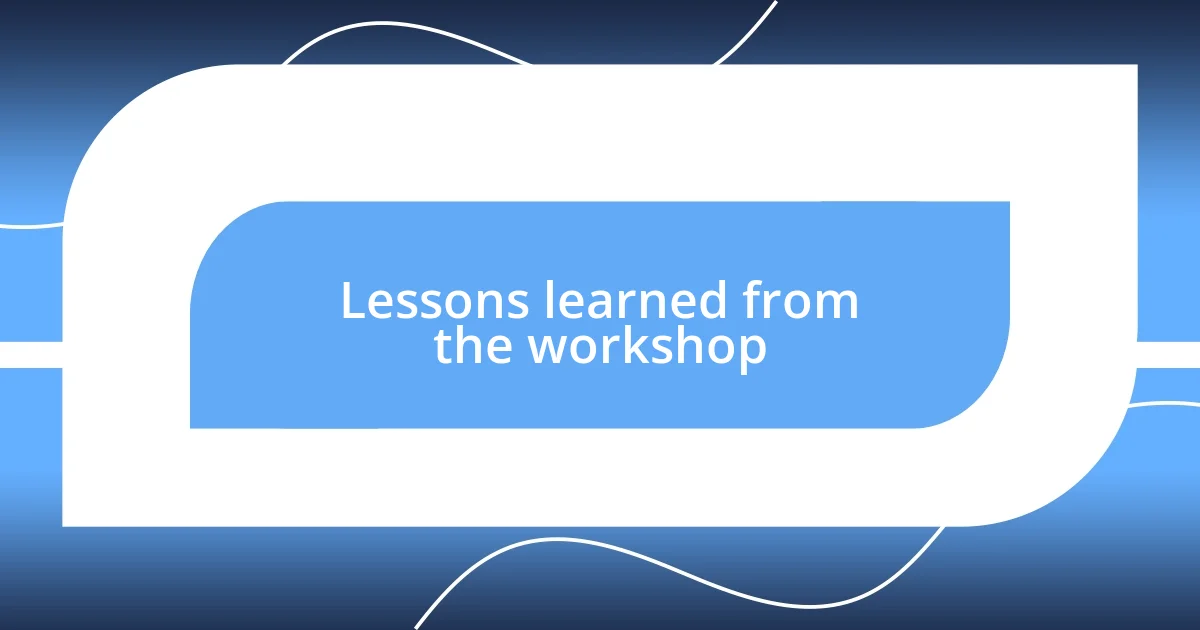Key takeaways:
- The selection of a workshop focused on personal and professional interests sparked passion and encouraged meaningful connections with like-minded individuals.
- Networking opportunities during the workshop fostered valuable relationships, personal insights, and a sense of community among participants.
- Applying the knowledge gained led to active involvement in local preservation efforts, emphasizing the importance of storytelling and community engagement in architecture.

Choosing a workshop to attend
When I set out to choose my workshop, I found myself overwhelmed by the options. There are countless workshops out there, each promising unique insights into historic architecture. Have you ever experienced that feeling of choice paralysis? I’ve been there, and it made me realize that I needed clarity on what I truly wanted to learn.
After narrowing down my criteria, I focused on workshops that not only highlighted well-known architectural styles but also included hands-on experiences. For instance, I remember coming across a workshop that offered guided tours of historic sites—which sparked my curiosity. The idea of not just learning, but experiencing the architecture first-hand ignited a real passion in me.
Ultimately, I chose a workshop that resonated with my personal interests and professional goals. I still think about how attending that particular workshop helped me connect with like-minded individuals who shared my enthusiasm. Have you ever found that special place where your interests align perfectly with what’s being offered? Those connections during the workshop made the experience even more unforgettable.

Preparing for the architecture workshop
Preparing for the architecture workshop required a bit of self-reflection. As I gathered my materials and set clear goals, I found myself considering not just what I wanted to learn, but how I wanted to feel during the workshop. There’s a certain excitement that builds up when you’re preparing for an event that you’ve anticipated for a while. Just thinking about diving into discussions around historic architecture stirred a sense of curiosity and wonder in me.
One of the most crucial steps for me was organizing my notes and resources. I created a dedicated folder filled with articles, sketches, and notes on architectural styles that intrigued me. I remember sitting at my desk and realizing how much I had already learned just through preparing. Having this groundwork laid out not only eased my nerves but also fueled my anticipation for immersing myself in the workshop environment, surrounded by people who shared my passions.
As I mapped out my trip and outlined my objectives, I also took time to mentally visualize the experience. Imagining myself interacting with experts and engaging in hands-on activities was exhilarating. How often do we envision the outcomes of our efforts? Reflecting on this process was eye-opening, reminding me of how preparation can shape the experience itself.
| Preparation Activity | Emotional Insight |
|---|---|
| Organizing materials | Built anticipation and confidence |
| Setting clear goals | Provided clarity and purpose |
| Visualizing the experience | Enhanced excitement for learning |

Networking opportunities during the event
While attending the workshop, I realized that networking was one of the most valuable experiences I could take away from the event. Throughout the sessions, conversations flowed naturally as we dove deep into discussions about historic architecture. I remember one particular moment when I connected with a fellow participant over our shared fascination with Art Deco buildings. It felt like meeting a long-lost friend who understood my passion and excitement.
Here are some of the key networking opportunities I encountered:
- Informal Lunch Breaks: These breaks allowed for casual conversations that often led to insightful discussions about personal projects and career paths.
- Group Activities: Collaborating on hands-on projects fostered teamwork and built rapport among participants, leading to lasting connections.
- Expert Q&A Sessions: Engaging directly with speakers after their presentations opened doors to deeper conversations and advice specific to our interests.
- Social Media Connections: Many attendees exchanged contact information for continued dialogue after the workshop, extending our network well beyond the event itself.
In the midst of these experiences, I found myself not only sharing my own insights but also absorbing a wealth of knowledge from others. That sense of community reminded me how powerful our field is when we come together, sharing both our passion and unique perspectives. It’s amazing how networking can turn into a supportive network of friends and collaborators.

Hands-on activities and experiences
As the workshop kicked off, I found myself immersed in activities that brought theory to life. We were not just passively listening; we rolled up our sleeves and got to work on model building. I distinctly remember the exhilaration that surged through me as I molded a miniature version of a historic structure. It was a blend of concentration and joy—there’s something truly magical about transforming ideas into tangible creations.
One memorable hands-on experience involved sketching architectural details right on-site. Walking through an old building, I felt my heart race as I tried to capture its intricate façade on paper. I can still feel the rough texture of the brick walls against my fingertips as I sketched, struggling to convey the centuries of history they held. Has there been a moment in your life when you felt completely in tune with your surroundings? For me, that was it. Every line I drew felt like a tribute to the stories embedded in the architecture.
Participating in group projects also added an invaluable layer to the experience. Collaborating with others on a restoration plan ignited stimulating discussions and creative brainstorming. I remember a moment when an idea sparked, and several of us excitedly exchanged thoughts. It felt like we were creating something meaningful together, and I realized how collaboration can elevate individual efforts. Engaging in these hands-on activities helped me understand that architecture isn’t just about aesthetics—it’s about community and shared experience.

Lessons learned from the workshop
During the workshop, I learned that every brick and beam tells a story. While working with my peers on a group project, we explored a dilapidated building and discussed its potential restoration. I felt a rush of inspiration as we pieced together our ideas, each person contributing unique insights. It made me realize how important storytelling is in architecture; it’s not just about how a building looks, but about the lives it has touched over the years.
One significant lesson was the importance of attention to detail. While sketching the ornate moldings inside a historic home, I became acutely aware of how every small feature contributes to the overall character of the structure. I thought to myself, how often do we overlook these intricate elements in our daily lives? This made me appreciate the beauty in simplicity and the craftsmanship that goes into creating memorable spaces.
Lastly, I found that the act of asking questions is invaluable. During a session on restoration techniques, I hesitated at first, fearing my questions might seem too basic. But once I opened up, I discovered that many attendees shared my curiosity. The discussions that followed were rich and enlightening, reinforcing the idea that vulnerability fosters learning. Who knew that embracing our uncertainties could lead to such profound knowledge?

Applying knowledge post-workshop
Putting the knowledge gained from the workshop into practice felt like stepping into a new world. After returning home, I started volunteering with a local preservation group, eager to use my newfound skills. I remember my first day; I walked through a neglected building, now filled with an urge to revive its historical essence. It was incredible to apply what I’d learned about restoration techniques while collaborating with people who shared my passion.
One particular project I worked on involved documenting a historic site that had been overlooked for years. Armed with my sketch pad and camera, I set out to record every detail, much like I had done during the workshop. There was an overwhelming sense of purpose as I immersed myself in the building’s history. Have you ever experienced that moment of connection where everything aligns? For me, each mark on the page felt like a bridge between the past and present, bringing me closer to the soul of the structure.
Incorporating the storytelling aspects of architecture in my community presentations became a focal point for me. I began to share the narratives behind each building, weaving the lessons learned from the workshop into my talks. There’s something incredibly fulfilling about igniting that spark of curiosity in others. It made me reflect—how often do we take the time to share the stories that shape our surroundings? Through these presentations, I felt my voice growing stronger, and it motivated me to continue advocating for the preservation of our architectural heritage.














